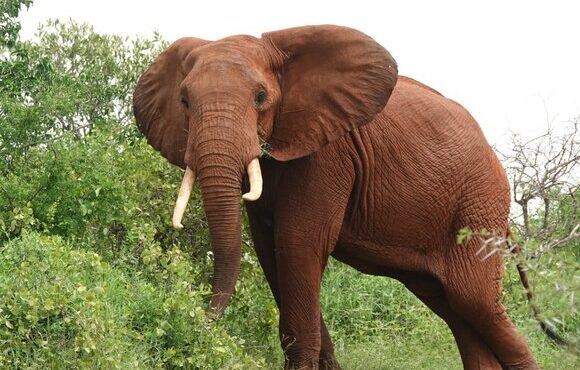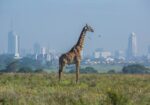Overview
Tsavo East National Park covers 13,747 square kilometers, making it Kenya’s largest protected wildlife sanctuary. Characterized by its wild, primeval landscape, the park offers an authentic and unmatched safari adventure. The terrain is generally flat and dry, with sparse vegetation that makes wildlife spotting relatively easy. The Galana River—one of Kenya’s largest rivers—cuts through the park, providing a vital water source for the animals.
Tsavo East is best known for its massive herds of dust-red elephants and its distinctive lions. Unlike typical members of the East African lion subspecies, the male lions in Tsavo are almost completely maneless and are known to actively participate in hunting, which is uncommon behavior. The park also supports an impressive bird population, with over 500 recorded species.
Historical Significance: The Man-Eaters of Tsavo
Tsavo East holds a legendary place in history due to the infamous “Man-Eaters of Tsavo.” In 1898, during British colonial rule, the construction of the Kenya-Uganda railway reached the Tsavo area. As workers began building a bridge over the Tsavo River, they set up camp nearby. During this period, two unusually large, maneless male lions began stalking the campsite at night. Developing a taste for human flesh, the lions killed and consumed an estimated 35 to 135 workers.
The attacks caused widespread fear, as victims were often dragged silently from their tents while they slept. The lions were eventually hunted and killed by Lt. Col. John Henry Patterson, the British engineer overseeing the railway project. Their preserved remains are now housed at the Field Museum in Chicago. This chilling chapter in Tsavo’s history has been retold in books and films, adding a legendary and eerie dimension to the wild beauty of Tsavo East.
Wildlife and Key Attractions
Mammal Life
Tsavo East National Park is home to over 60 species of mammals, making it a haven for wildlife enthusiasts. One of its most iconic sights is the famous red elephants of Tsavo, which appear red due to their habit of bathing in the park’s red-oxide soil. This behavior helps cool their bodies and protects their skin from insect bites. Tsavo supports some of the largest elephant populations in Kenya.
The park is also known for its distinctive maneless male lions, which are more actively involved in hunting compared to typical lion behavior. Cheetahs are also frequently seen roaming the open plains. Tsavo East is one of the few places outside northern Kenya where visitors can spot members of the rare Northern Five, including the blue-necked Somali ostrich and the gerenuk, an antelope with an unusually long neck that stands on its hind legs while feeding, resembling a giraffe.
Other carnivores in the park include leopards, spotted hyenas, striped hyenas, African wild dogs, servals, caracals, jackals, and African civets. The grasslands are home to herbivores such as Cape buffalo, lesser kudu, warthogs, dik-diks, Coke’s hartebeest (kongoni), and the critically endangered hirola (Hunter’s hartebeest). Eland, plains zebras, giraffes, waterbucks, and rock hyraxes are also common, each adapted to different habitats from savannahs to rocky outcrops and swamps.
Primates are widely distributed across the park and include baboons, black-faced vervet monkeys, and Syke’s monkeys. Rivers and dams attract large aquatic species such as hippos and giant Nile crocodiles, especially during the dry season. The park also shelters smaller mammals like mongooses, porcupines, pangolins, and hyraxes, contributing to the area’s rich biodiversity.
Birdlife
Tsavo East National Park boasts one of the richest bird populations in Kenya, with over 500 species recorded. The savannah and woodland areas are home to a wide variety of resident birds, including ostriches, golden-breasted starlings, red-billed and Von der Decken’s hornbills, black-headed lapwings, secretary birds, crested francolins, black-faced sandgrouse, white-headed buffalo-weavers, lilac-breasted rollers, eastern chanting goshawks, bateleur eagles, martial eagles, and African hawk eagles.
Wetland and water birds can be seen around the park’s rivers, swamps, and dams. Notable species include the goliath heron, African jacana, open-billed stork, hamerkop, African spoonbill, yellow-billed stork, great egret, sacred ibis, and white-faced whistling duck. These birds are most often spotted in and around major water sources such as the Galana River and Aruba Dam.
Between October and April, the park welcomes migratory birds from Europe and Asia, along with intra-African migrants. These seasonal visitors include the European roller, Eurasian bee-eater, common swift, Amur falcon, barn swallow, lesser kestrel, steppe eagle, willow warbler, and white stork. The diversity of habitats ensures that both resident and migratory species thrive.
Whether in the dry plains, riverbanks, or swampy basins, birdwatchers can expect to encounter an incredible variety of avian life throughout the year. Tsavo East’s unique blend of habitats makes it a top destination for both amateur and professional birders seeking rare sightings.
Scenic Landscapes
Tsavo East features mostly flat terrain with vast red-soil plains and open savannahs dotted with sparse vegetation. The Galana River, formed by the merging of the Tsavo and Athi rivers, cuts across the park and brings life to the otherwise dry landscape. Its lush riverbanks contrast with the surrounding dust-colored plains and attract large numbers of animals, especially during the dry season.
One of the park’s most striking features is Luggard’s Falls, where the Galana River flows through narrow, sculpted rock formations before plunging into powerful rapids. Below the falls, Crocodile Point marks a deep pool known for its concentration of Nile crocodiles. This section of the river offers dramatic scenery and excellent wildlife viewing.
To the north of the Galana River lies the Yatta Plateau, a prehistoric lava flow stretching nearly 300 kilometers. Believed to be the longest lava flow in the world, it forms a rugged ridge that dominates the northern landscape. This area, while geologically significant, is currently restricted to public access for conservation reasons.
Additional scenic points include Kandari Swamp, set against a backdrop of hills and known for attracting wildlife and waterbirds. Visitors should also watch for leopards resting in the trees. Aruba Dam, built across the seasonal Voi River, acts as a key water source and wildlife hotspot. Nearby, Mudanda Rock rises 1.5 kilometers above Mudanda Dam and is especially popular with elephants during dry periods.
Activities and Experiences in Tsavo East National Park
Game Drives
Guided game drives are one of the best ways to explore the vast wilderness of Tsavo East. Visitors travel in 4×4 vehicles fitted with pop-up roofs, allowing for panoramic views and excellent wildlife spotting opportunities. Drives are usually scheduled for early morning and late afternoon, when temperatures are cooler and animals are most active. During the midday heat, many animals rest in the shade, making them less visible. For those seeking a deeper encounter with the landscape and its wildlife, full-day game drives can also be arranged.
Bird Watching
With over 500 recorded bird species, Tsavo East is a paradise for bird watchers. The park’s diverse habitats such as savannahs, wetlands, and riverine forests support a wide variety of both resident and migratory species. Birdwatchers can enjoy sightings throughout the year, with particularly high activity during the migratory seasons.
Photography
The park offers stunning opportunities for wildlife and landscape photography. Popular subjects include the iconic red elephants, dramatic skies over open plains, the Galana River valley, Mudanda Rock, Aruba Dam, and the Yatta Plateau—recognized as the world’s longest lava flow. Whether you’re photographing birds, big game, or sweeping landscapes, the scenery provides striking compositions in all directions.
Picnics
Designated picnic sites near Voi Gate and Aruba Lodge offer a chance to rest, eat, and take in the surroundings. These areas are generally safe and scenic, often within sight of wildlife, though caution is advised. They provide a relaxing break during game drives or long travel days, all while keeping you immersed in the park’s natural beauty.
Best Time to Visit
The best time to visit Tsavo East National Park largely depends on what you want to experience. The dry seasons, from June to October and January to February, are ideal for wildlife viewing. During these months, animals gather around water sources, making them easier to spot. However, this is also the peak tourist season, so expect larger crowds and higher accommodation prices, especially between July and October.
The short rains in November and December usually do not disrupt safari activities and can be a great time to visit. The rains bring a fresh burst of greenery across the park, and it’s also the best time for bird watching as migratory species arrive. Accommodation prices are often lower during this period.
The long rains from March to May can make safari activities more challenging. Wildlife and birds spread out across the park due to the abundance of water and food, which can make sightings less predictable. However, this season sees fewer tourists, lower accommodation costs, and a quieter experience overall. Some park roads may become impassable, and mosquitoes are more common during this time.
Where to Stay in Tsavo East National Park
Tsavo East National Park offers a wide range of accommodation options to suit all types of travelers, including luxury lodges, mid-range camps, and budget-friendly campsites.
Budget Campsites
For budget travelers, basic campsites are available and provide essential amenities such as communal water points, shared toilet and bathroom facilities, and a simple kitchen area. These camps offer a more rustic experience for those looking to enjoy nature at minimal cost.
Mid-Range Camps and Lodges
Mid-range options strike a balance between comfort and affordability. These accommodations typically include well-furnished tents or rooms with en-suite bathrooms, hot showers, mosquito nets, electricity, and in some cases, swimming pools, bars, and lounges. Meals often include buffet options with greater variety. Many are located within the park or just outside its boundaries, often overlooking waterholes or open areas where wildlife regularly gathers.
Luxury Camps and Lodges
For travelers seeking exclusivity and indulgence, luxury camps and lodges offer high-end experiences. Accommodation includes designer safari tents or spacious suites, often featuring private decks, plunge pools, and spa services. Guests can enjoy personalized service, gourmet cuisine, and a high level of privacy. These properties are usually set in scenic and secluded parts of the park that offer excellent opportunities for game viewing right from your room or veranda.
How to Get There
Tsavo East National Park is located in southeastern Kenya, just outside Voi Town, along the Mombasa-Nairobi Highway. The park is easily accessible by both road and air, making it a convenient destination for travelers planning a safari adventure.
By Road: Traveling by road is the most common and scenic way to reach Tsavo East. From Nairobi, the drive to the Voi Gate covers approximately 330 km and takes about 6 hours. From Mombasa, it’s about 100 km to Buchuma Gate, taking roughly 3 hours. Road access from nearby parks is also possible, making Tsavo East easy to include in a longer safari itinerary. The journey itself offers beautiful views of Kenya’s rural landscapes and is often considered part of the safari experience.
By Air: While there are no scheduled commercial flights directly to Tsavo East, the park is served by several airstrips that accommodate charter flights. Private and chartered flights are available through providers such as AirKenya and Safarilink, offering quicker access and breathtaking aerial views of the park. This option is ideal for travelers with limited time or those seeking a more exclusive safari experience.
Tsavo East National Park Safari Packages
Tsavo East is a perfect destination for travelers seeking adventure, wildlife, and striking geological landscapes. Safari packages range from exclusive single-park experiences within Tsavo East to multi-park itineraries that combine visits to other popular destinations such as Tsavo West, Amboseli, and the Masai Mara. These packages are available for both individual travelers and groups, catering to a variety of interests and budgets.
Compared to more crowded parks like the Masai Mara, Tsavo East offers a quieter, more private safari experience, making it ideal for those who prefer fewer tourists and more intimate wildlife encounters. Whether you’re planning a short getaway or a longer Kenyan safari circuit, Tsavo East can be tailored into a memorable and flexible travel plan.
Conclusion
Tsavo East National Park offers one of Kenya’s most genuine and immersive safari experiences. Its sweeping landscapes, iconic dust-red elephants, abundant birdlife, and striking features like the Yatta Plateau and Galana River create a backdrop of raw, untamed beauty. Whether it’s the park’s legendary history, its diverse wildlife, or the sense of seclusion away from the crowds that draws you in, Tsavo East delivers a rare blend of adventure and serenity.
The park caters to all kinds of travelers with its range of accommodation options, from basic campsites to luxury lodges. It is easily accessible by both road and air and offers flexible safari packages, whether you’re planning a dedicated visit or combining it with other destinations like Tsavo West, Amboseli, or the Masai Mara. For solo travelers, families, birdwatchers, or photography enthusiasts, Tsavo East promises an unforgettable and rewarding safari experience.
Ready to plan your Tsavo East safari?
At Giorgi Safaris, we specialize in tailor-made Kenya safari holidays crafted to match your interests, schedule, and travel style. Our packages include expert safari guides, reliable 4×4 vehicles with pop-up roofs for optimal game viewing, and thoughtfully designed itineraries that showcase the very best of each destination.
We partner with trusted lodges and camps to ensure your experience is smooth, enjoyable, and truly unforgettable from the moment you arrive to the moment you leave.
Contact Giorgi Safaris today to book your safari or request a custom itinerary tailored to your travel goals. We’re here to help you make the most of your time in one of Kenya’s most iconic and accessible wildlife destinations.









